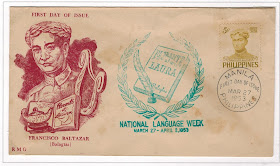With over 100 different languages spoken in the Philippines, Spanish and English were used between filipinos not sharing a common mother tongue. President Manuel Quezon wanted one of the native languages to be selected as the Philippines bridging language.In 1937, Quezon declared Tagalog, spoken as a first language by over 25% of the population, as the basis for a "National Language". In 1939, the national language was named "Wikang Pambansâ" . Twenty years later, in 1959, it was renamed as Pilipino and in 1973 the name of the language was changed to Filipino.
National Language Week
On March 26, 1946, President Sergio Osmeña issued Proclamation No. 35, designating March 27 to April 2 of each year as National Language Week. The observance ended on the birthday of Francisco “Balagtas” Baltazar (1788-1862), known as the “Prince of Tagalog Literature” and author of the Tagalog epic, Florante at Laura.
1952 : Slogan Cancellation
A Tagalog slogan cancellation was used at the Manila post office to publicize National Language Week:
WRITE AND SPEAK THE NATIONAL LANGUAGE
NATIONAL LANGUAGE WEEK
MARCH 27 - APRIL 2
1953 : Postage Stamp
The Bureau of Posts issued a commemorative stamp on March 27, 1953 to mark National Language Week. The stamp features a bust of Francisco Baltazar.
First Day of Issue Cachet
Although no reference is made on the stamp that National Language Week is being commemorated, the Post Office cachet provides that information.
Baltazar's poem Floranta at Laura, the central element of the cachet, has been described as "romantic and lyrical in inspiration, social in intent, and allegorical in conception."
First Day Covers











